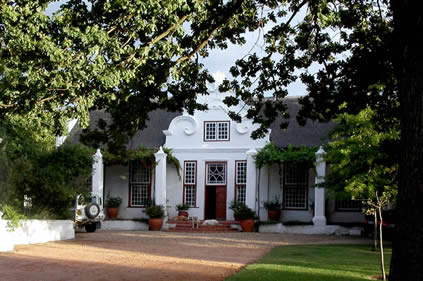|
The wines
of Morgenster,
Somerset West, South Africa
PO Box 1616,
Somerset West, 7129 South Africa
E-mail: info@morgenster.co.za
Website: www.morgenster.co.za
 Once
part of the original Vergelegen estate, Morgenster was purchased by
Giulio Bertrand in 1992, who set about restoring it to former glory. The first vineyard plantings were in 1994, and the last
were in 2002. From the start a decision was made to concentrate on
Bordeaux varieties. Merlot and Cabernet Sauvignon dominate, with a
good chunk of Cabernet Franc and a tiny bit of Petit Verdot. It’s
perhaps by concentrating their focus that Morgenster have established
themselves as one of the leading South African proponents of Bordeaux
blends, as the notes below indicate. Once
part of the original Vergelegen estate, Morgenster was purchased by
Giulio Bertrand in 1992, who set about restoring it to former glory. The first vineyard plantings were in 1994, and the last
were in 2002. From the start a decision was made to concentrate on
Bordeaux varieties. Merlot and Cabernet Sauvignon dominate, with a
good chunk of Cabernet Franc and a tiny bit of Petit Verdot. It’s
perhaps by concentrating their focus that Morgenster have established
themselves as one of the leading South African proponents of Bordeaux
blends, as the notes below indicate.
There are currently 40 hectares planted, exclusively to
red, although there are plans to do a white with Sauvignon Blanc and
Semillon. The soils are weathered Swartland shale; they are fairly
decomposed. The vineyards are on steep slopes ranging from 50 to 360 m
above sea level, planted at a density of 3000 vines per hectare, and
crop at 3.5–6.5 tons/hectare.
Pierre Lurton consults here. His first visit was in
1998 during the world cup, when France won; he usually visits in July
and February each year. I asked him about his views on natural wines.
‘For me, naturalness is very important’, he responded, but he’s
not tempted to join the natural wine brigade who refuse to add
anything to their wines at all, including sulfur dioxide. ‘Sulfur
dioxide addition is necessary for the wine to have good balance:
without it there is a big risk of brettanomyces’, maintains Pierre.
He added that filtration is also needed. ‘We have a problem with
high pH and low acidity, which is a biologically unbalanced situation.
If you don’t rack and fine it is dangerous to put the wine into
bottle without filtration.’ For red wine he chooses to add cultured
yeast, but for white, if the material is clean he uses natural yeasts,
but if there is any rot he’ll use cultured yeast. ‘For whites,
natural yeasts have a lot of interest on the aroma’, he adds.
‘Natural yeasts are very interesting in Sauternes’.
Morgenster
The Summer House 2002
Soft, smooth ripe berry flavours with a subtle herbal
character. Very silky tannins. Quite refined and classy. Very good+
88/100
Morgenster
Lourens River Valley 2000
Distinctively earthy character to the savoury dark
fruits, which combines well with the mineral and spice overtones.
Nice. Very good+ 89/100
Morgenster
Lourens River Valley 2001
Classy minerally edge to the ripe berry fruit. Good
structure here with a nice spicy finish. Elegantly styled. Very
good/excellent 90/100
Morgenster
2000
Dark, smooth elegant black fruits nose with a tarry,
spicy edge. The palate shows supple black fruits with smooth but firm
tannins and a subtle herbal note in the background. Impressive
classically styled wine, with good structure and acidity backing up
the sweet fruit. Very good/excellent 92/100
Morgenster
2001
Ripe, supple smooth dark fruits nose is sweet and
perfumed with some complexity. The palate is smooth with a minerally
edge. Quite spicy, this is evolving nicely, like a very ripe claret.
It has a minerality to it, and combines power and elegance. Very
good/excellent 93/100
see
also: South African
series
Wines tasted 11/05
Find
these wines with wine-searcher.com
Back to top
|

